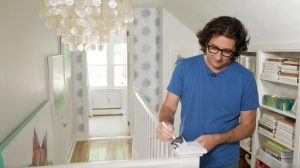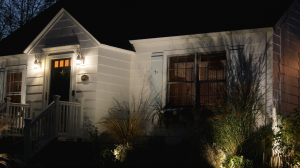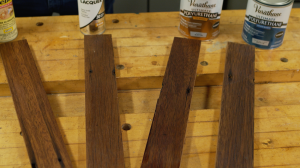RON HAZELTON:
Well, it's a beautiful day for a drive. I'm headed down to Asheville, North Carolina to visit one of the largest homes in America. Constructed in the mid-1890s by George Washington Vanderbilt, grandson of industrialist Cornelius Vanderbilt, as a country home, the Biltmore has 250 rooms of priceless antiques and works of art and is the centerpiece of 8,000 lush acres featuring world famous sculpted gardens. It takes a thousand-person staff to operate and maintain this magnificent estate.
Today, I'm going to meet some of them and pick up a few tips that are useful in maintaining just about any home, not just the 250-room variety.
So, you know, we all have got screen doors or screen windows but how many have you got here?
MAN:
Twelve-hundred.
RON HAZELTON:
Twelve-hundred [LAUGHS].
Well, that may be more than the average home but most of us have to replace those screens once in a while. And that's what resident carpenter Andy Grades is doing today. Now I always find it a challenge getting a new screen taut enough. But I suspect that's going to be a cinch for Andy.
We first pry off the molding, remove all the nails and staples, then rip out the old screen.
Okay, Andy, here's the screen. It's aluminum, right?
ANDY GRADES:
Yes.
RON HAZELTON:
Andy trims the screen, leaving some excess around the edges, then secures two adjacent sides with staples.
ANDY GRADES:
Now Ron, I like to put these about every inch-and-a-half, two inches apart.
RON HAZELTON:
Okay, now, you got these two sides done. Still got a little bit of a sag in here. This is where it gets tricky for me. What's your technique for pulling this taut?
Andy explains that once the two adjacent sides are stapled, he stretches the screen across the width of the door and staples the opposite edge. Then he pulls the screen lengthwise to remove the last remaining ridges.
So can I hold this for you over here?
ANDY GRADES:
Sure.
RON HAZELTON:
Now how do you know when you've got it tight enough?
ANDY GRADES:
When you can bounce a quarter on it.
RON HAZELTON:
Oh, really? The quarter test, huh? Maybe we'll try that.
ANDY GRADES:
Maybe, you got a quarter? [LAUGHS]
RON HAZELTON:
I was going to borrow one from you.
Andy places his knife in the corner of the frame and makes a 45-degree cut outward to the edge of the screen. Now he can stretch the final side taut and staple it in place. Finally, he trims off the excess screen and replaces the molding.
Well, as I — as I say in my book, good as new or good as old when working on a house like this.
ANDY GRADES:
Yes.
RON HAZELTON:
Ready for the quarter test?
ANDY GRADES:
I guess.
RON HAZELTON:
Your, your quarter or mine?
ANDY GRADES:
Well, is yours lighter?
RON HAZELTON:
[LAUGHS] No.
ANDY GRADES:
Thanks.
RON HAZELTON:
— supposed to do?
ANDY GRADES:
That's what it's supposed to — it's supposed to do.
RON HAZELTON:
Yeah. I'd say you did it, huh? I learned something. Thanks, Andy.
ANDY GRADES:
[LAUGHS] Now give me my quarter back.
RON HAZELTON:
Oh, oh, sorry.
[ANDY LAUGHS]
Older paned windows like the ones here at the Biltmore estate, as well as those in many homes rely on putty — sometimes called glazing, to hold the individual pieces of glass in place. Over time, this glazing gets brittle and needs to be replaced.
Wade Ledford is the Biltmore's resident expert. Hey, Wade.
WADE LEDFORD:
Hey, how you doing?
RON HAZELTON:
Looks like it ought to be good for some soldering, but you're about to do some work here with the glazing.
WADE LEDFORD:
Yeah.
RON HAZELTON:
How are you going to use the torch?
WADE LEDFORD:
I'm going to use the torch to heat up the old glazing, to be able to remove it from the window a lot quicker and a lot easier. Okay, I put the putty knife up against the vice and what I'm doing, I'm aiming the heat right down on the putty knife onto the glazing instead of hitting it directly and this — and this will soften it up.
[BOTH AT ONCE]
And this enables me to get it off a lot easier. You may have to do it a couple times to get it all off but normally, the first time it takes it right off —
[BOTH SPEAK AT ONCE]
RON HAZELTON:
I'll be darned. You know, I can't tell you how many times I've struggled getting that old putty out, just trying to chip it out. And I — well, I have, I've broken the glass on occasion.
WADE LEDFORD:
Oh, you break a lot of glass by doing it like that. Doing it like this is a — a lot easier. You can use a hairdryer you know, if you don't have a torch or you can use a — a heat gun to — to use to strip paint with to do it.
But always remember, you know, do not apply the heat directly to the glass.
RON HAZELTON:
Heating old glazing, making it easier to remove is a tip I'll use for a long time to come. I'm about to learn another trick of the trade.
WADE LEDFORD:
As you see here, the glazing is real sticky. It loves to stick to anything and really loves to stick to your putty knife and your hands more than anything. But what I've learned to do — if I can drive some of the oils up in it, this helps me to, you know, be able to work with it a lot better and so forth.
So what I use there is just a plain old everyday —
RON HAZELTON:
Oh, come on, baby powder?
WADE LEDFORD:
— baby powder.
RON HAZELTON:
I'll be darned. Do you put it on the — on your hands or on the putty?
WADE LEDFORD:
On the — I put it on the putty and keep working it in there.
[BOTH SPEAK AT ONCE]
RON HAZELTON:
I feel the difference right away, the powder makes the putty much more manageable. Yep. This tip's another keeper.
WADE LEDFORD:
Okay. What I do here, I'm — I'm just forming this out in kind of a, a smaller round circle. And when I do that, I'll just place it up here and take my putty knife and I just, you know, press it in here and keep working it. And keep pressing it in till I get down here to the corner.
Once I do that, then you find the angle and where I'm talking about the angle is where the other sides come to and you just take your putty knife and just press down hard and just come down, take the excess off and just —then just smooth her up.
RON HAZELTON:
Oh, it's pretty neat.
The baby powder also seems to allow the putty to release more easily from the blade.
WADE LEDFORD:
This here, you did good and I think you'd make a good worker on it.
RON HAZELTON:
Well, thank you. [LAUGHS]
WADE LEDFORD:
You're welcome.
[MUSIC]
RON HAZELTON:
When you visit the Biltmore, it takes a while for the sheer size of this place to sink in - 34 bedrooms, 43 bathrooms, a gymnasium and even a bowling alley. It took 135 tons of slate tile to cover the roof. Much of the woodwork in the Biltmore is a hundred years old, and caring for it over the past century has meant applying coat after coat of linseed oil.
Removing it is a job that falls to preservation expert, Pat Ray.
This is a beautiful oak under here —
PAT RAY:
Yes it is.
RON HAZELTON:
— you're sort of re-covering, right?
PAT RAY:
We're taking the linseed oil and the dirt off.
RON HAZELTON:
That's all that's on here that's making this that dark, huh?
PAT RAY:
That's all that's on here, Mm-hmm [AFFIRMATIVE].
RON HAZELTON:
For decades, it's been common practice to apply linseed oil with the thought that it protected the wood. But because the linseed oil never completely dries, it actually attracts dust and dirt like a magnet.
The trick is to remove the accumulated dirt and oil without damaging the finish underneath. For this, Pat uses wood alcohol or methanol.
PAT RAY:
Now you have to know what kind of wood. If it's a real soft wood, that's not a very good idea.
RON HAZELTON:
Okay.
PAT RAY:
We — all we have is oak, so it's very good for oak.
RON HAZELTON:
So, it's just a matter of like just rubbing this back and forth.
PAT RAY:
Mm-hmm [AFFIRMATIVE].
RON HAZELTON:
I mean, look how easy that comes off, yeah.
After the wood is thoroughly cleaned, Pat will protect the surface with a coat of beeswax. When completed in 1895, the house was not only America's largest private residence, it was also one of the most modern, with hot water on demand, a central heating system and electricity. The folks I met here today care for the Biltmore estate as though it were their own.
The techniques they use can be useful to many of us in caring for our own homes — even if we don't have 250 rooms.





